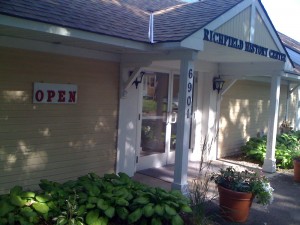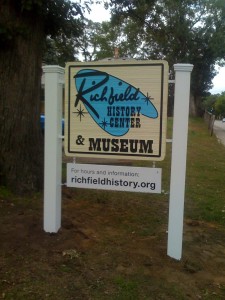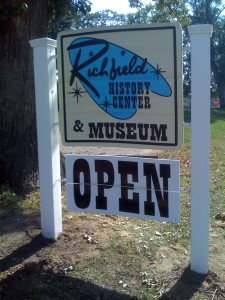If any of you are following me and have wondered if I have died or fallen off the edge of the world, fear not I have been blogging over at Minnesota Local History for my new position as Digital Technology Outreach Specialist in Local History Field Services. For now I plan just to post over there but I haven’t given up on this site….
The following is  my comment to a great blog post by Jim Richardson on Dealing with negative comments on social media:
Two things, first:
As the old saying goes:
“If your business involves unrepentantly clubbing baby seals maybe you shouldn’t be engaging the public with social mediaâ€
I think when you start engaging using social media you have to be keenly aware of your organization’s weak spots. You should be ready to deal with poor or misleading information on the part of the poster but more importantly you should be willing to listen, take feedback and use it to guide and change your organization. If not, then your organization should stay way from social media, you’re only using up time and energy that could be better spent bludgeoning baby seals to death for fabulously soft fur coats.
Secondly, deciding whether or not to risk engaging is one consideration, deciding just how to handle it is another consideration.
At the organization I work at we are working on creating social media guidelines and have mashed together the following six points by looking at what others have put together before us for their social media guidelines.
1. Ignore them or delete the comment
Not usually the best course of action, this should be a last resort. If you are dealing with some one trolling this may be the only course of action.
2. Attempt to pacify them
Bribery with a 50% off coupon may work but it does not solve issue since you are just trying to make the problem go away.
3. Address (but don’t Antagonize them) them
This is always the best course of action. A negative comment can become a great opportunity for your organization to improve itself (see first part above).
4. Contact your boss, PR, etc…
If in doubt as to what to do contact a department supervisor or someone that can give you advice on how to handle the matter.
5. Have a firm policy in place on the blog/Twitter/Facebook site
Having a comment or anti-negativity policy in place.
6. Ban the offending party
Don’t be afraid to ban someone who constantly creates a negative environment. If some one is being a troll, remember it is not their community, it’s yours.
~end comment.
I would like to conclude with the following from Intel’s Social Media Guidelines:
“Follow these three principles: the Good, the Bad, but not the Ugly. If the content is positive or negative and in context to the conversation, then we approve the content, regardless of whether it’s favorable or unfavorable to us. But if the content is ugly, offensive, denigrating and completely out of context, then we reject the content.â€
“The Atlantic” published a not-so-flattering article on the Brooklyn Museum’s handling the deasscesioning and storage of it’s architectural fragments collection. Terry Carbone, a curator at Brooklyn Museum, posted the Brooklyn Museum’s response on their blog. They then solicited comments from the public on their Twitter and Facebook social media channels to post their questions and comments on the blog.
The blog post is overly formal and comes across as if PR wrote the post rather than the curator as it does not fit the writing style of the rest of her posts so it lacks a bit of genuineness and risks sounding condescending and dismissive. However, otherwise I think it was handled well and given the controversial nature of the subject it was probably better to be conservative in the writing style.
Some observations… It was an interesting preemptive tactic to invite the public on their social media channels to post comments on their blog.
- Having comments on their blog directs any attacks and comments way from other Brooklyn Museum accounts. The blog post functions as a proverbial blast wall that is helping to direct the blast.
- While the comments may be negative it is still on their forum. The dialog will happen, but it is better to be part of the dialog helping direct the discussion rather than outside of it.
- The blog post is highly specific to traffic and less public than a Facebook wall or twitter feed.
I am curious what other people’s observations are on this.
The following was mega-comment I left on Nina Simon’s excellent blog post “Where’s the Mobile Museum Project for Intact Social Groups?” My comment addresses other comments on the post as much as it does Nina’s article. After writing my comment I figured it might make a good post to my own blog.
There seems to be a contradiction in some of the arguments here. First there is a discussion that museums should go beyond the audio tour and be creative and do more with mobile devices, specifically use it to expand the social experience. but then there seems to be the argument inferring that smartphones – specifically the iPhone, is a minor part of a larger mobile market and we need to design for even-access to technology and make sure dumbphones, which make up the largest part of the mobile market, are included.
A museum can attempt a “one size fits all approach but I suspect it will severely tie it’s hands when it comes to solutions for the user and social experience. Taking a scavenger hunt and moving it from paper to mobile without adapting it to use the power of the technology is not much better than using mobile for audio tours. You might as well just keep the scavenger hunt on paper and the audio tours on tape recorders.
One interesting thing is that iPhones account for 50% of all mobile browser traffic for U.S. based smartphones, and 33% of global smartphone site visits. That number is being challenged by Android but still both Android and the iPhone ofter a rich user experience with an intuitive interface not to mention the legions of developers working on apps, something not available for most mobile devices.
Not only can a museum can have iTouch/iPad (or Android equivalent) devices to loan or rent out with the app preinstalled, but users with their own devices can download the app or maybe even a lite version of the app and they can play out the game by themselves or join others.
By interacting with objects and people in the exhibit through 2-D barcodes or through RFID tags you can not only find and harvest objects you could trade them with others, cash them in for points or use them to build a spaceship/train/boat at a common interactive terminal and move on to a higher goal.
The important point here is game development, particularly if you want your mobile to “go social”. I suspect that exhibit developers are great at telling stories but telling stories is a much different skill set than writing/creating games. To create a game you have to understand about game parameters such as scalability, complexity and setting as well as game archetypes such as treasure hunts, survival games and economy games. I suspect the lack of the social mobile experience at museums could reflect a lack of game development experience itself.
Since I work on the front line doing web design as well as online marketing it can be easy to have contempt for the ignorant wretched hordes that storm the web site for information along with the uninformed plebs that ask for the web site to be built in the first place with little or no concept of how web design and development really works.
But tisk tisk, I also need to remember that good web design is good PR.
When it comes to social media most get it, if not in practice then in theory. There is the well known story of Comcast’s customer service manager Frank Eliason who came uses Twitter to listen and interact with customers and deal with questions and complaints. (I hope you are listening to your users through social media).
However, when it comes to your plain-ol’-web site, is your web site a good listener? and more importantly, is your web site a good helper? Is it respectful? is it courteous?
It goes without saying that you should have away for users to contact you. If not through a form then through an regularly checked email account such as webmaster@yourmuseum.org
Also listening to your users by means of analytics and surveys. The analytics give you the numbers – unique pageviews, bounce rates etc. Surveys help make sense of the numbers by giving you the customers intent.
Analytics is more than just a popularity contest between web pages. It can tell you if users your site are finding the information they need or are leaving frustrated and confused.
![]() As far as surveys, the simplest (or the least unobtrusive) survey would be to include a “Rate this Page” and feedback widget on every page (or at least every page on certain sections). One of the nicest implimentions that I have seen so far was on Informz.com. Sadly while they provide email and and survey support their rate this page widget is not available as of yet.
As far as surveys, the simplest (or the least unobtrusive) survey would be to include a “Rate this Page” and feedback widget on every page (or at least every page on certain sections). One of the nicest implimentions that I have seen so far was on Informz.com. Sadly while they provide email and and survey support their rate this page widget is not available as of yet.
And as far as dealing with the uninformed plebs asking me to design or help with their web content..? Jim Cheshire a Microsoft Expresion, Moderator posted a great anecdote on that subject which helps remind me all have our talents and that the brightest people can be the worst web designers and we need to respect and we patient with that and appreciate each other for the knowledge and talents we have.
When my sister was in town I took her back to see our old high school. It is a beautiful 1930s gothic building that one time housed a cloister. But times change and the cloister closed and the school has since seen many changes including an addition with a new gymnasium. Both her and I wanted to see the changes that had recently occurred. We parked and walked around the exterior looking at the recent additions to the building when a maintenance person, probably checking up on who these strangers were on the grounds after hours, asked us if he could help. We explained that we were alumni and were checking out the new changes. Not only did this man engage us and let us know of all the changes that have taken place to the building he gave us an impromptu tour of the building showing us what the cloisters were now used for, updates to the commons, the theater, and even the updates to the fire safety system. Needless to say we were impressed not only by the changes to our old school but by the polite helpfulness of this man who undeniably went above and beyond his job description. I later sent in a unsolicited donation for his troubles.
My sister, who also happened to be the director for the National Eagle Center, commented that you can’t buy that kind of public relations and an employee like that is the best PR and organization can have. She herself had a similar situation when in the early days of the National Eagle Center when she gave an impromptu tour to someone that showed up just as she was locking up for the day. This person was so impressed that they became not only a great volunteer for the center but also a very generous donor as well.
This brings up an issue that I have noticed with several museums. Yes, the front desk people whose jobs may be dependent on being polite and helpful are cheery but what about the rest of the staff? What about your director, your curator, your exhibit designer, your web designer and yes your maintenance staff? Chances are if it is not their job, they are not. While they may not be rude and dismissive (sadly some are) are they proactively looking to help visitors or going out of their way to be polite? Are non-customer service staff
Museums have small marketing budgets (at least most). One of the greatest marketing tools they rely on and one of the most effective is word of mouth. Â One of the cheapest PR tools out there and the most effective, is good employee interactions with customers. Some of the extra good deeds I have spied at the Minnesota History Center during my time here have been an employee on their way home offering to return a borrowed wheelchair to the front desk from the parking lot; walking a visitor in the rain out to their car with an umbrella; helping carry a visitor’s tray from the cafeteria to their table; talking time to help visitors get to where they need to go; numerous people opening doors for visitors; etc…
I worked in a hospital which placed great emphasis on employee etiquette and courteousness. Good etiquette and courteousness didn’t happen there by chance, the hospital did quite a bit of employee training on the subject, if nothing else employee got it that this was considered both important by the organization and meant to be practiced by all.
So what does all this have to do with online marketing and PR? Well, in my next post I will talk about the overlooked PR potential of employee helpfulness, etiquette and courteousness in the online environment.
My post last April was on the Minnesota History Center’s curious problem with Google Maps which, among may issues, listed the Minnesota History Center site as “Miller Hospital.” While it was true that Miller Hospital was on the site, the facility was demolished 30 years ago. The current History Center building was built in 1992 – 17 years ago. It baffles the mind on how Miller Hospital could have been listed in the first place. The Minnesota Historical Society staff and fans pointed that fact out to both Google and Tele Atlas, on several occasions but with seemingly no effect.
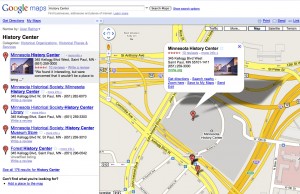 Then October 2nd, the Teleatlas truck was sited in Downtown Saint Paul and while it may be purely coincidental, on October 10th I noticed that Google Maps correctly identified the site as “Minnesota History Center” as well as the “Minnesota Historical Society” Â and “Miller Hospital” was gone!
Then October 2nd, the Teleatlas truck was sited in Downtown Saint Paul and while it may be purely coincidental, on October 10th I noticed that Google Maps correctly identified the site as “Minnesota History Center” as well as the “Minnesota Historical Society” Â and “Miller Hospital” was gone!
Not only that, but the work claiming, correctly placing and deleting duplicate or irrelivant listings in Google Maps has begun to pay off. When searching for the Minnesota History Center or the Minnesota Historical Society you are not set around the Metro area on a wild goose chase. However, as the graphic will a testify to, while owned by the Minensota Historical Society, the Forest History Center is no where near the Minnesota History Center. Â Work still needs to be done on claiming and getting the listings correct for MHS’ other historic sites and museums.
Every so often children have a funny way of helping you realize that how much technology has changed our basic notions of how we interact with the world. I had a small one quite awhile ago attending a local fair in Minneapolis while watching a performer on the children’s stage talking with the kids and interacting with them with them by watching a “pretend” TV and then he asked all the kids and their parents to change the channel. He and the parents pantomimed changing the channel by turning a knob on the TV set, the kids however changed the channel by pantomiming holding a remote control and aimed their remotes at the performer and pressed the “buttons” on the remote with their thumb.
Another time was when I was chatting with a friend of mine recently about his own technology paridime shift when he was looking at his friend’s four year old daugther watch “Dora the Explorer” on TV when suddenly she got up in the middle of the program and begin to rummage around the back of he TV set in the snake pit of wires. His first thought and reaction was how cute, she is pretending to be Dora and was exploring. As the four year old became increasingly fustrated it was clear that she was not exploring at all. He asked her what she as doing and she replied she was looking for “the mouse”. Interactivity with media was so commonplace with this four year old that she felt it her right that she should be able to control the show on TV.
 I see quite a bit written on social and online media for and by large museums. Not much is written from a smaller museum’s perspective with staffing of one or less. In addition to working for an organization of several hundred staff I also sit on the board of a small little tiny neighborhood historical society – the Richfield Historical Society, whose needs and goals are decidedly different than that of a large museum.
I see quite a bit written on social and online media for and by large museums. Not much is written from a smaller museum’s perspective with staffing of one or less. In addition to working for an organization of several hundred staff I also sit on the board of a small little tiny neighborhood historical society – the Richfield Historical Society, whose needs and goals are decidedly different than that of a large museum.
For example…
For over two years we planned and designed a roadside sign that would advertise our presence to the community and drivers by. It took that long because of city approval of changes and of course having to raise funds to help pay for the sign. It also took long due to ongoing changes in the design, partly reflective of unsureness of what to have on the sign which reflected the marketing of the organization and the brand itself.
What to put on the sign went right to the core of how we identified as organization. People were fine with the 50’s style logo and branding however, there was a lengthy debate on whether it should be the” Richfield Historical Society” or the “Richfield History Center” or simply “Museum” which is as clear as ice to the passing motorist as to what we are. Also debated was what else should be on the sign. There was an agreement that having hours on the sign would be nice, but like most small museums our hours were both infrequent and chaotic and would make the sign too busy to read quickly.
While people may plan their visits to larger museums, visits to smaller museums appear to be more driven by impulse. It was important to have a sign that identified quickly who we were and and when they could come.
However, during the two years while we planned and planned our new sign we had almost nothing identifying our site. We were losing customers as the time passed.
Enter Norm
Norm was another board member. He was not a good designer, nor did he have any thoughts (or care) as to what branding was about. But he did have the common sense to understand that without signage not many folks will know who or where you are.
While the committee met and raised funds for a new sign and decided what to put on it, Norm quietly put up his own signage identifying the building as well as a simple sign letting the world (at least those driving by) know when we were open By hanging an open sign, we significantly increased our daily traffic with folks walking in often saying “I always drove by and wondered what you guys were, I am so glad you are open”.
A highly visible open sign. So simple and yet often over-looked at small museums.
With that knowledge I went to task to redesign (yet again) our organizations roadside sign. This time eliminating any mention of hours or other information and instead listing our web site where people can look up the hours (whatever they happened to be at the time) along with other information but however we including space for a large “OPEN” sign to capture the impulse intellectual. The resulting sign built by Mathey Sign was a success.
There is a smaller sign listing the Richfield Historical Society’s web site which unfolds to become the OPEN sign. Once in place this improvement has greatly increased the traffic and exposure of the Richfield Historical Society. The final changes to the sign included the use of the name of the building “Richfield History Center” rather than the “Richfield Historical Society” in an effort to promote the place not the organization running it. It also (after some debate) included “& Museum” which was short hand for the other building on the site the Bartholomew House. Museum was added to help the site get instant recognition and understanding from drivers passing quickly by that “History Center” may not have. In the same way that “Spa” or “Health Club” may mean many things to different people but when you say “Spa & Brothel” the term is, well, rather crystal clear. (yes, yes… I know its risqué but its the only example I could think of at the time of writing this post).
Norm sadly passed away not much longer after putting up his simple hand made signs which were very effective in helping the organization. In spite of their crudeness and lack of brand savvy I find it hard to remove them and probably will keep them around for a while, …one of the privileges of volunteering at a small museum.
I made an earlier remark about the trend of museums and organizations pushing large amounts of their content on-line in spaces like Flickr with not much consideration of how to use it to pull customers back into their own web spaces or facilities or actively engage with their organization.
Debra Askanase of the blog, Community Organizer 2.0 wrote an article on the innovative ways three arts organizations are using Flickr creatively, engaging and empowering stakeholders and doing a good job of pulling Flickr users to their organizations.
1. The Houston Ballet uses Flickr to give users a look behind the scenes in their warehouse and the creation of props. Behind the scene tours are appealing to just about anyone but they are particularly appealing to museums hardest sell, teens which are interested in knowing how things work under-the-hood.
2. The Mass Museum of Contemporary Art (MassMOCA) and The Luce Foundation Center for American Art both used crowdsourcing to engage and pull in viewers. The Mass Museum of Contemporary Art asks viewers to upload photos specific to an assigned topic. The topics usually relate to one of the exhibits happening at the time.
3. The Luce Foundation Center for American Art pulls off both crowdsourcing and is able to introduce users to it’s collection by engaging them as citizen curators to find appropriate works of art of size to fill-in-the-gaps in their display units  while matching the other artworks in theme.
MHS on Flickr
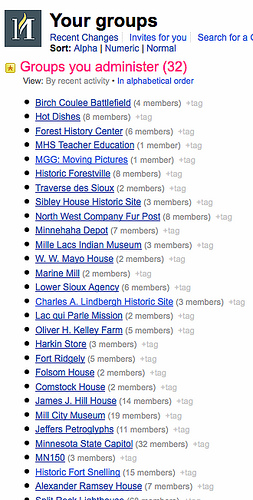 Where I work, the Minnesota Historical Society does a lot of content “push” on Flickr, adding items from its collection, event photos, historic site photos nothing (as of yet) as clever or engaging on Flickr as the previous three mentioned. It’s pull is limited to the basic making sure photos are marked up properly with titles, captions and tags.
Where I work, the Minnesota Historical Society does a lot of content “push” on Flickr, adding items from its collection, event photos, historic site photos nothing (as of yet) as clever or engaging on Flickr as the previous three mentioned. It’s pull is limited to the basic making sure photos are marked up properly with titles, captions and tags.
One thing discovered while adding photos on Flickr of the historic sites we manage  was just how few good contemporary photos we actually had of the sites but not only that our customers seemed to be taking much better and more numerous photos than we could or were. Flickr seemed the perfect place to do a little simple crowdsourcing-light of our own by asking others on Flickr to add their photos they have taken of our sites to the site’s equivalent group on Flickr. With that we were able to pull in the photos to our site using a widget to give viewers a better idea of what the site looks like.
While this is a good step it is inspiring and nice to see other museums using Flickr to engage and pull viewers back to their collections and museums in creative ways.
